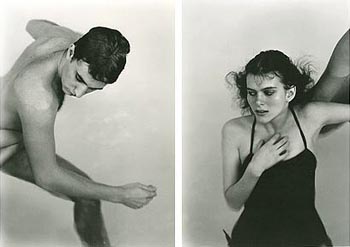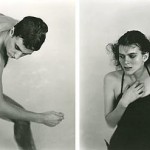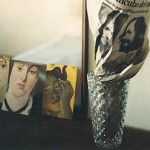By CARL GUNHOUSE
Trashing the Museum of Modern Art has become a sport for art critics since it reopened in 2004. Jerry Saltz complained that MoMA focused too heavily on the greats of art history, presenting a predictable and homogenized view of art history [1]. The Village Voice recently went so far as to assert that MoMA was unable to put on even the most basic of winning art shows and calling the recent “What is Painting?” exhibition an “emotionally-draining” experience [2]. Yet since the reopening, MoMA’s photography department has consistently presented an eclectic selection of younger photographers in its permanent collection and given space to unheralded photographers in its New Photography series. And it now follows its very well received Jeff Wall exhibition with an excellent mid-career retrospective of the undervalued JoAnn Verburg. An artist who by Chelsea standards wouldn’t even merit an illustration in Vanity Fair’s art universe and recently appeared on Alec Soth’s ever popular photography blog as one of the most underappreciated women photographers, Verburg has appeared in group shows at the MoMA, the Whitney Museum, International Center for Photography, and George Eastman House, as well as in solo exhibitions at Pace/MacGill Gallery, Robert Mann Gallery, and the legendary Light Gallery, forming a resume your average MFA student would do unseemly things for.
MoMA has done exactly what a museum should do in our ever more commercial art world. It has risen above current tastes and given high-profile space to an artist the curators believe deserves greater consideration, as opposed to mounting an exhibition like the Whitney Museum’s Summer of Love: Art of the Psychedelic Era that is geared solely to bringing tourists in the door.
Verburg’s lack of contemporary fame in no way reflects on the quality and contemporary importance of her photographs. She constantly pushes her work in an oddly sweet yet daring way, showing miniature videos of light on water and fuzzy pictures of sand pyramids along with her more successful pictures of domestic interiors and Italian landscapes. At a time when younger artists seem to present nothing but work that is resolved conceptually before it is even created, it is invigorating to see works in progress, pictures that often serve as enjoyable, if barely successful experiments, that even in failure are terribly enjoyable. The still lives of her and her husband’s shared space which accompany her large collection of multi-paneled portraits of her husband often make little sense, as inUntitled (Homage to Atget) or Still Life with Serial Killers. In both, it is assumed there is a willingness by the viewer to join Verburg in game of stupefying free association. Her use of text in almost every picture of her husband and their environment can often seem forced as can her practice of combining multi-panels to create a single picture, like a visual gimmick that substitutes for interesting content. And that says nothing of her earlier multi-paneled portraits of artists that resemble Richard Avedon test strips.
Yet despite all this, it is hard to walk away from the show without a certain excitement about the medium and the gift of sight. The work revels in the immediate and its visual pleasures. Everything exudes a vibrancy, even the non-events Verburg delicately composes of her ruffled husband asleep. Her work, like the best of photography, challenges the viewers to pay more attention to the world around them: an invitation to stare more at your coffee cup, at a reflection in a picture frame, or simply at the face of the person with whom you choose to share your day. Because you might see something great or, as Susan Kismaric noted in her description of 3 x Jim, you might discover the “ . . . ultimate inability to transcend our fundamental aloneness. [3]
Not only do Verburg’s pictures celebrate life in general but they very specifically describe the life of an aging rather erudite couple who spend a great deal of time enjoying the day and reading the New York Times. Verburg’s pictures turn her husband into a composite human being culled from the DNA of everyone with a subscription to the New Yorker on a Mediterranean vacation. Yet unlike the culturally elite dollhouse world of Tina Barney, Verburg’s pictures feel real. They focus on the specific, intimate details of a life, yet allow a space for the viewers to supply their own subtext.
But what really makes Verburg’s work sing is how she uses the camera to perceive color and visual space. While working in the 70's on the Rephotographic Survey project, she dreamed of “a large verison of a photograph that could be entered like a landscape.” [4] This was the genesis of her Italian landscapes of olive trees. The pictures are some of her most current and confirm that Verburg may just, at the age of 57, be coming into her artistic prime. The photographs are spectacular; the entire series maintains the inverse of Cezanne’s color palette; everything is a breezy, grayish blue-green with delicate little swaths of clayish orange. Picture after picture halts the fluttering of late daylight as it winds through the leaves and descends behind the horizon. Verburg’s photography captures light and its colors in a way rarely seen by the human eye. The landscape photographs finally justify the form of the multi-paneled images. Each panel has a separate sliver of focus creating the sensation of an actual living space which you can enter and visually meander through, not a three-dimensional space rendered in two-dimensions. From a distance, the many panels become a large panoramic image. These pictures are the visual realization of Impressionism. They create a world where, the lack of visual clarity is the most effective way of recreating the experience of seeing.
- Series of images from the catalog, Present Tense: Photographs by Joann Verberg, currently on view at the Museum of Modern Art in New York.
[1] Village Voice, Return Engagement, Jerry Saltz, 11-19-04
[2] Village Voice, Anxiety of Influence, Christian Viveros-Faune, 8-20-07
[3] Present Tense Susan Kismaric and JoAnn Verburg, Museum of Modern Art 2007
[4] Present Tense Susan Kismaric and JoAnn Verburg, Museum of Modern Art 2007
"Present Tense: Photographs by JoAnn Verberg" is on view until November 5th at the Museum of Modern Art at 11 West 53 St., New York.
All images are courtesy of the artist and the Museum of Modern Art.







